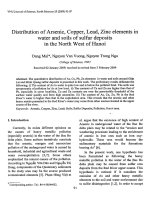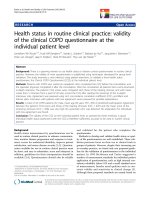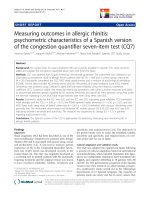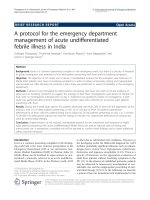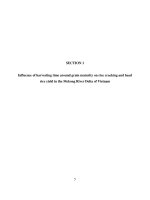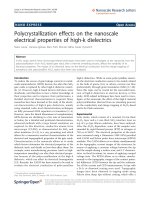Tarn Hoa plums (Prunus salicina) in the maize based system in the north west highlands of Vietnam
Bạn đang xem bản rút gọn của tài liệu. Xem và tải ngay bản đầy đủ của tài liệu tại đây (670.03 KB, 8 trang )
Tam Hoa plums (Prunus salicina) in the maize-based
system in the North-West Highlands of Vietnam
L.B. Bonney1, O. Nicetic2, R. Collins2, A. `Le Quoc3, H. Đặng Thị3, T. Hoang Thanh3, A. Đào Thế3,
T.T.H. Nguyen4 and H. Pham Van4
1University
of Tasmania, Hobart, Australia; 2University of Queensland, Brisbane, Australia; 3Centre for Agrarian
Systems Research and Development (CASRAD), Hanoi, Vietnam; 4Vietnam National University of Agriculture
(VNUA), Hanoi, Vietnam.
Abstract
Tam Hoa plum is one of three hybrids of the Japanese plum (Prunus salicina),
originating from southern China, and grown between 700 and1000 m altitude in
north-west Vietnam for the domestic market. Along with some leguminous crops
grown in rotation with maize, plums are an important source of additional income for
smallholders. The aim of the project was to develop competitive value chains for
plums with high levels of smallholder engagement. The research design was both
structured and adaptive, based on participative action research. In addition, sensory
evaluation to determine optimum measurable indicators of ripeness (soluble solids
and hardness) based on consumer preferences was conducted to adjust time of
harvesting. The research found that Tam Hoa plum production and marketing is a
large, complex system that is interconnected with the marketing of green (immature)
plums to China and other substitutable fruit such as lychees, longans and other plums.
It is a highly opportunistic, low-input system the outputs of which depend on plum
prices, the relative production capability of districts and local microclimates. The 40to 45-day plum harvest season is highly variable regarding harvesting dates, harvest
duration, plum quality and, consequently, market prices. It was established that there
is sufficient profit margin for all chain participants to establish a sustainable niche
value chain based on high-quality sweet plums if reliable and sufficient throughput
can be achieved. It is recommended that future similar value chain projects pay
particular attention to selecting large ‘aggregators’ and ‘distributors’ so as to achieve
volume and stable market access.
Keywords: temperate fruits, value chains, profitability, market interactions
INTRODUCTION
Vietnam has 53 ethnic minority groups, accounting for 12.6% of the total population,
who for the greater part inhabit the mountainous areas in the north-west and north-east
regions and the Central Highlands. In 2006, 52% of ethnic minority people were reported to
live in poverty, in comparison with 10% of the Kinh majority group. The main reasons for
this disparity have been summarised as differences in assets, capacity and voice (van de
Fliert et al., 2010).
The North-West Highlands provinces are among the poorest in Vietnam, with a
regional poverty ratio of 28% compared with an average of 10% across the country, and
rural poverty increased in the period 2008-2012 (ILRI, 2014). Lack of market integration,
inappropriate and unsustainable land management and limited ability of poor smallholders
to absorb risk have resulted in continued poverty within the region. The ethnic minority
people, who dominate the North-West Highlands, are increasingly disengaged from the
benefits of a rapidly developing Vietnamese economy, and approximately 75% remain below
the international poverty line, contributing to their persistent poverty (United Nations, 2002;
United Nations Development Programme, 2013).
In the North-West Highlands, the dominant agricultural system is based on maize
production, with temperate fruit being a smaller but important part of the system. Maize and
temperate fruit production are complementary, because they provide local smallholders
Acta Hortic. 1128. ISHS 2016. DOI 10.17660/ActaHortic.2016.1128.14
XXIX IHC - Proc. Int. Symp. on Horticulture in Developing Countries and
World Food Production
Eds.: A. Gracie, M. Taguchi and G. Rogers
103
with options to spread production and marketing risk for household income.
Temperate fruit production provides 62% of smallholders’ annual income in some
areas; however, the temperate fruit industry is also characterised by poor market
engagement, low yields, high post-harvest losses (25-40%) and low profitability, which
result in low incentives for farmer investment in improving production and marketing
practices.
One of those temperate fruits, Tam Hoa plums (Prunus salicina), is a significant crop in
Mộc Châu District in Sơn La Province in north-west Vietnam, with a total production of
17,000-25,000 t from 1719 ha (Mộc Châu Extension Centre). The Tam Hoa plum is one of
three hybrids of the Japanese plum (Prunus salicina), originating from southern China, that
are grown between 700-1000 m altitude, mainly for the domestic market, in Vietnam. In
1995, 1000 certified disease-free plum rootstock seeds were planted in 11 provinces. The
original plantings of about 32,400 ha expanded to approximately 100,000 ha over the last 15
years. Sơn La Province, with approximately 12,000 ha, is now the second-largest growing
area (Cao-Van and Chau, 1999). During the early 2000s, many trees were removed as a
result of a major fall in demand; however, the Mộc Châu Extension Centre (Son La) estimates
1719 ha is presently in production.
Due to the rapid market transformations currently underway in agriculture and their
potential impact on smallholder livelihoods, temperate fruit production was investigated,
focusing on the potential for both technical production and marketing practice changes. This
paper describes the temperate fruit component of ACIAR Project ‘AGB/2008/002 Improved
market engagement for sustainable upland production systems in the North West Highlands
of Vietnam’.
METHODS
The research design for the temperate fruit component was both structured and
adaptive to the emerging research questions and findings. It was a participative action
research design (Heron and Reason, 2001) incorporating a cycle of learning, reflection and
improvement. However, other appropriate methods (e.g., sensory testing, householder
analysis and biophysical testing of ripeness) were also incorporated to build understanding
of the variables operating on this system.
The aim of the project was to increase smallholder engagement in competitive value
chains associated with maize- and temperate fruit-based farming systems.
Three villages investigated in this component were in the Mộc Châu District, Pieng
Sang, a Dao minority community, Co Do (Kinh, Thai and Hmong) and Ban On (Kinh and Thai).
In all villages, farmers cultivate crops in small fields, many on slopes. The average size of
agricultural landholdings in villages in Son La province is 2.71 ha.
A rapid supply chain analysis (Collins and Dunne, 2008) was undertaken in Mộc Châu
and Mai Sơn Districts of Son La Province to map the market mechanisms, constraints and
opportunities for more profitable farming systems for smallholders. This analysis identified
that China frequently provides a large market outlet for green Tam Hoa plums, so plum
traders in western Jiangxi Province, P.R. China, were interviewed at a wholesale market close
to the border between Vietnam and China (25 km). This was followed by a 2-day visit to the
wholesale market and supermarkets in Nanning, the capital of the Guangxi Zhuang
Autonomous Region in southern China. Supermarket and speciality fruit retail interviews
were undertaken in Hà Nội (Hanoi) to identify and validate the market potential, followed by
consumer sensory testing and surveys correlated with objective testing of plum
characteristics (size, colour, firmness and sugar content) to determine plum value attributes.
In 2011, a full value chain analysis (VCA) was undertaken, involving more extensive,
confirmatory sensory evaluation with consumers. Value-chain-building workshops were
conducted before the plum season (May-June) with smallholders and supply chain members
to link market opportunities with current capacity. These were followed by annual
collaborative value-chain planning meetings to review progress and emergent problems.
During the short plum season, continuous monitoring and advising on harvesting, packing
and transporting, along with monitoring of prices in the Hà Nội markets and at the various
104
stages of the chain to smallholder farmers, was conducted as part of an assessment of the
project’s impact on chain benefits.
RESULTS AND DISCUSSION
Tam Hoa plum production and marketing is an activity carried out by many thousands
of households across Moc Chau District and is a much larger, more complex system than
originally envisaged, being interconnected with the marketing of green plums to China and
the market for other substitutable temperate fruit such as lychees, longans and other
cultivars of plum. It is a highly opportunistic, low-input system the results of which depend
on plum prices, the relative production capability of communes and local microclimates
(earliness and quality). The plum harvest season is highly variable for date and duration, but
usually extends over 40-45 days, with a mid-season of 20-25 days and a premium price
period of 7-10 days at the beginning of the season. In Pieng Sang Village and, to some extent,
Co Do Village, low-quality fruit are a major constraint to more profitable marketing of plums.
However, recent access to the Chinese green plum market has increased the demand
significantly and stabilised the average price at a level that is profitable for farmers. The lack
of capital and market information was identified as the major non-natural resource
constraint for future growth of agricultural enterprises in the village.
Ban On was recognised as having the best-quality plums, but, to achieve high quality
attributes, harvesting is delayed by 10 and 15 days compared with Pieng Sang and Co Do,
respectively. This creates a tension for the Project (Hi-Q) Plum Chain because of the pricequality balance. Earliness is a key value attribute for consumers, and there is some
willingness by farmers to trade ripeness to achieve the earliness and premium prices that
are associated with the first 7-10 days of the season. In the latter stages of the season, ripe
plums are in abundance in the wet markets and do not command premium prices. Hence,
farmers from Ban On are keen to get to market as early as possible with fruit that, whilst it is
higher in quality than Pieng Sang and Co Do plums, may compromise the standards required
by the project’s Hi-Q Plum Chain marketing protocols.
Mộc Châu has two main channels for marketing its Tam Hoa plums: the green plum
channels into China and the ripe plum channels to both north and south Vietnam, with Hà
Nội being the dominant destination market (Figure 1).
Figure 1. Mộc Châu Tam Hoa plum value chains with typical relative product volume flows.
Source: interviews with collectors in Mộc Châu, 2010-2013. Relative volumes are
estimates. No official records are available.
105
Consumer value analysis indicated that consumers valued colour, sweetness, size,
firmness and freedom from blemishes. The creation of these value attributes occurred
largely on the farm (sweetness, size and colour) and at the local collector (level 1) (grading
for colour, size, blemish and packing to preserve quality). VCA also highlighted the absence
of market information and feedback and the lack of relationships between the upstream and
downstream partners in plum chains. Sensory evaluation established that perception of
sweetness is closely related to colour and that, once 11 °Brix is reached, consumer
preferences are not correlated to the objectively measured sugar content. This finding
indicates that the balance between quality and being early enough in the market to capitalise
on higher prices may be achieved by harvesting at 11 °Brix, providing fruit has changed
colour from dominantly green to deep red (Tables 1 and 2).
Table 1. Relative contribution of objective consumer value attributes to the preference and
purchase decision (2011).
Attribute
Sweetness (°Brix)
Hardness (kg cm-2)
Colour of skin (0
yellow-green, 1
purple-red)
Influence decision to buy
in early season
Adjusted R2=0.216
S
Adjusted β
S
P=0.452 0.101
P=0.279
P=0.010 -0.067
P=0.481
P=0.002 0.374
P=0.001
Overall preference
Adjusted R2=0.272
Adjusted β
0.041
-0.239
0.334
Influence decision to buy
in main season
Adjusted R2=0.238
Adjusted β
S
-0.067
P=0.466
-0.205
P=0.029
0.392
P<0.001
Table 2. Relative contribution of perceptions of consumer value attributes to preference and
purchase decision (2011).
Attribute
Perceived
sweetness
Perceived
hardness
Overall preference
Adjusted R2=0.556
Adjusted β
0.686
S
P<0.001
0.101
P=0.149
Influence in purchase
decision in early season
Adjusted R2=0.269
Adjusted β
S
0.383
P<0.001
0.204
P=0.024
Influence in purchase
decision in main season
Adjusted R2=0.280
Adjusted β
S
0.389
P<0.001
0.211
P=0.019
The investigation of the market for green plums in Pingxiang and Nanning in southern
China showed that the demand for Vietnamese Tam Hoa plums is dependent on the price
and availability of the Chinese Man Com variety, which means demand is highly
unpredictable. However, recent interviews with Moc Chau traders revealed that the green
plum market has recently extended to Guangdong province, tending to make the market
more stable. The factors driving Chinese demand are:
• Chinese large-scale domestic production, which is difficult to forecast, as it is
strongly affected by climate and disease;
• International market demand for processed plums, which is also unpredictable, due
to fluctuating internal and global economic conditions.
When Chinese demand is high, green plums are diverted from Vietnamese production
areas into that market, but, if the demand is low and the Vietnamese season is good, prices
are driven down in Vietnam by a glut. As a consequence, some trees are not harvested in
some years. However, other factors also influence the price of ripe plums:
1. Competition and substitution by other similarly priced fruits (longans, lychees,
rambutans and other types of plums) occurs due to the large variation in the timing
106
2.
3.
4.
5.
6.
and duration of the plum harvest period, as well as the rate of ripening. This may
mean that, when the premium price period for plums coincides with that of those
fruits, substitution may occur, moderating the price of Tam Hoa plums (Figure 2);
The profitability and workload of competing enterprises in Moc Chau district such
as cattle production, tea harvesting and dairying;
Ripe plum harvesting is much slower than for green plums (100-150 versus
400-500 kg person-1 day-1), which means a higher cost of production for ripe plums;
Green plums have a much shorter harvesting season, of 5-10 days, whilst ripe
plums have a peak mid-season of 20-25 days. So, if the farmer has more profitable
enterprises, then the longer, more complicated engagement with harvesting ripe
plums is an opportunity cost for his livelihood.
Marketing green plums avoids the cost and effort involved in fruit fly control.
There are increasing farm labour shortages for plum harvesting because the trees
in many orchards have been planted too close together and allowed to grow
without pruning which, in some instances, has resulted in the canopy becoming
intertwined, making picking difficult.
Figure 2. Seasonal competitors with Tam Hoa plums. (1) Source: Nguyen et al. (2005); (2)
source: Jiang et al. (2002); (3) the scientific and varietal names of these fruit are
not known.
Green plums are usually harvested from the warmer hilly slopes, commonly starting
nearly 10 days earlier than for ripe plums. Some areas such as Pieng Sang and Co Do are
early areas, but produce poorer-quality ripe plums, and this is an important decision-making
factor for farmers supplying green or ripe plum markets. As soon as the higher-quality areas
start harvesting, the prices for these poorer-quality supplies drop significantly. Therefore,
farmers in areas producing poorer-quality plums make early decisions to optimise their
income by selling to the Chinese market if the prices are reasonable, thus minimising the
risk that they will receive no income from plum production. The decision to supply the green
plum markets has recently been made easier because green plum prices have been steadily
rising. In early season 2013, nearly 300 t day-1 (approximately seven trucks with a loading
capacity of 40 t truck-1) were being sent to the Chinese market.
Plums are climacteric fruits, so they continue to ripen after harvest. However, cultivars
of Prunus salicina show a diversity of climacteric behaviour (Singh et al., 2012). Thus, during
the project, there was major variation in harvesting dates, harvest duration, quality and,
consequently, market prices.
Over the 4-year period of the project, major price variations occurred, and green plum
production increased, whilst ripe plum production declined. Some districts appeared to
accept that they could not consistently achieve the best prices in the ripe plum market and
so sold early to the Chinese green plum traders. Economic analysis indicated that there
appeared to be a potential for premium-quality plums in high-quality greengrocers in Hà Nội.
The project monitored production and engaged in awareness-raising activities in three
communes for 2 years, but the farmers in only one commune, Ban On, voted to proceed with
establishing a High-Quality Plum (Hi-Q) Chain as part of the project. In 2011, arrangements
107
were made with three high-quality greengrocers in Hà Nội to participate in the chain, and
the Ban On farmers trialled grading at harvest as well as grading at the local collector level.
The season was very late, resulting in ripe plums competing with other substitutable
temperate fruit, so the prices were only moderate for the Hi-Q chain. The 2011 results
indicated the need for the new chain to be very early to market, with consistently highquality fruit, and the need to increase throughput by involving more wholesalers and
retailers. It also demonstrated that grading whilst harvesting was not economic, because the
pickers were only 40% as efficient.
Economic analysis of the 2012 data (Table 3) showed that the Hi-Q plum chain was
able to achieve a higher net benefit for all chain participants over the traditional ripe plum
chains, as well as the low-input green plum chains to China. Further, the net benefit to the
four retailers of Hi-Q plums ranged from VND 65,000 to 175,000 per day and VND 2,489,500
to 6,648,000 for the 2012 season.
Table 3. Comparison of profit and net benefit to chain stages from different plum marketing
channels (2012).
Green plums
Chain stage
Farmer
Collector
Wholesaler
Retailer
Net profit
(VND)
2405
650
NK
NK
Ripe plums
Net profit
(VND)
4232
4140
300
5900
Net profit
(VND)
11088
6294
N/A
8800
Hi-Q plum chain
(Ban On Farmer Interest Group)
Net benefit
Net benefit
vs. ripe
vs. green
6856
8683
2154
5644
N/A
NK
2900
N/A
The 2013 season activities focused again on increasing throughput and the number of
outlets, achieving the largest total throughput of 3 t.
CONCLUSIONS
Project results showed that:
• There is sufficient profit margin for all the chain participants to establish a
sustainable niche value chain if sufficient throughput can be achieved;
• Engaging with large collectors and wholesalers is important for improving
smallholder systems;
• There are few opportunities for farmers to ‘add value’ for other chain members to
justify sharing premium price;
• Plums are highly substitutable with other fruits, presenting difficulties for
establishing large, stable, coordinated chains;
• Opportunistic production and marketing are very difficult to coordinate;
• Where the opportunity and motivation to improve is low, chain members will not
be willing to invest;
• The market price is highly dynamic, dependent on diverse, uncontrollable
conditions, and therefore risky for smallholder investment;
• Not all supply chains are suitable for coordinated supply;
• Future value chain projects based on smallholder production systems should pay
particular attention to selecting large ‘aggregators’ and ‘distributors’ so as to
achieve required volumes and stable market access.
ACKNOWLEDGEMENTS
The authors wish to acknowledge the funding and assistance provided by the
Australian Centre for International Agricultural Research (ACIAR).
108
Literature cited
Cao-Van, P., and Chau, N.M. (1999). Deciduous fruit production in Vietnam. In Deciduous Fruit Production in Asia
and the Pacific, M.K. Papademetriou, and E.M. Herath, eds., FAO/RAP Publication (Bangkok, Thailand: Food and
Agriculture Organization of the United Nations Regional Office for Asia and the Pacific), p.90–96.
Collins, R.J., and Dunne, A.J. (2008). A rapid supply chain appraisal approach for agribusiness development
projects. Acta Hortic. 794, 73–80 />Heron, J., and Reason, P. (2001). The practice of co-operative inquiry: research ‘with’ rather than ‘on’ people. In
Handbook of Action Research: Participative Inquiry and Practice, P. Reason and H. Bradbury, eds. (London, UK:
Sage Publications), p.179–188.
ILRI. (2014). A Situational Analysis of Agricultural Production and Marketing, and Natural Resource Management
Systems in Northwest Vietnam (Nairobi, Kenya: International Livestock Research Institute, for CGIAR HumidTropics Research Program).
Jiang, Y., Zhang, Z., Joyce, D.C., and Ketsa, S. (2002). Postharvest biology and handling of longan fruit (Dimocarpus
longan Lour.). Postharvest Biol. Technol. 26 (3), 241–252 />Nguyen, T.D., Truong, T.M., and Dao, T.A. (2005). Analyzing Thieu Litchi Value Chain in Thanh Ha District, Hai
Duong Province (Hanoi, Vietnam: Vietnam Agricultural Science Institute and GTZ-MOT-METRO), pp.38.
Singh, S.P., Singh, Z., and Swinny, E.E. (2012). Climacteric level during fruit ripening influences lipid peroxidation
and enzymatic and non-enzymatic antioxidative systems in Japanese plums (Prunus salicina Lindell). Postharvest
Biol. Technol. 65 (0), 22–32 />United Nations. (2002). Millennium Development Goals: Bringing the MDGs Closer to the People (Hanoi, Vietnam:
United Nations in Vietnam).
United Nations Development Programme. (2013). The rise of the south: human progress in a diverse world. In
Human Development Report, K. Malik, ed. (New York, NY, USA: United Nations).
van de Fliert, E., Vuong, P.T., Hien, D.T.M., Thomas, P., and Nicetic, O. (2010). Out of comfort zones, into realities:
research for development with upland ethnic minority communities in North West Vietnam. Paper presented at:
9th European IFSA Symposium (Vienna, Austria).
109
110


